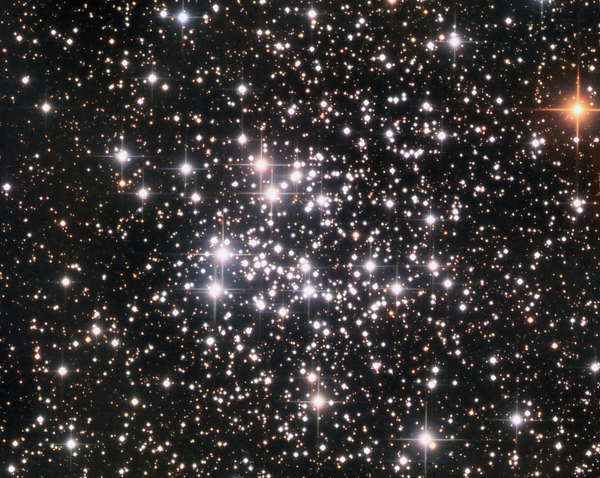NGC 663 in Cassiopeia
October 2023 - Nebula and Cluster of the Month
During October, the galactic equator passes very nearly overhead, bringing with it a wealth of open clusters. Nowhere is this more evident than in Cassiopeia. The galactic equator passes just north of the ‘wonky W’ until it cuts the asterism roughly halfway between the stars δ and ε Cassiopeiae.
The sky is full of open clusters great and small in this region and proves a rich hunting ground for the cluster-seeker. One of the largest and brightest of the objects in this region is NGC 663, located about 2,200 parsecs (7,200 light-years) away from us, in the Milky Way’s Perseus arm. It is probably part of the Cassiopeia OB8 association. Other open clusters in the region within the association are NGCs 654 & 659 and M103.

It was discovered, of course, by William Herschel, who first saw it on 21 September 1788. He described it as A beautiful cluster of pretty large stars near 15’ diameter. Considerably rich.
He placed it in his class VI ‘Very compressed and rich clusters of stars’ as number 31.
As is typical, the Trumpler type for this object varies with the source. The Deep-Sky Field Guide to Uranometria 2000.0 (once its text is converted to a Trumpler type) gives II3r, meaning that the cluster is well detached but has little central condensation, that the magnitudes of the member stars are widely ranged and that the cluster is rich (i.e., over 100 stars). The number of member stars is given as 80 (contradicting their own definition) and the magnitude of the brightest star is given as 8.42.
Archinal & Hynes in Star Clusters also give a type of II3r, but suggest 108 member stars, the brightest of which is, they say, magnitude 9.0. The Night Sky Observer’s Guide (Volume 1) gives a somewhat stunted Trumpler type of III2, detached with no concentration, only a moderate range of brightnesses.
All I can suggest is that you go out and look for yourselves.
The cluster is young, with the dominant bright stars mostly being B-type. There are a large number of Be-type stars amongst them, that is, B-type stars whose spectrum displays emission lines. The prototype Be-star is γ Cassiopeiae, which lies 6° west of the cluster. There are currently (as of 2015) 42 emission-line candidates within the cluster1, though it is thought that not all of these may be giant B-type stars.
NGC 663 is clearly a young cluster, with an age calculated at 20—25 million years2.
From a visual perspective, NGC 663 is a very pleasing cluster, being large and bright and immediately obvious. I observed it with my 12” (300mm) Newtonian reflector and found it to be bright, large and rich. About 100 stars were seen splashed liberally across the 20' field. The brighter stars are in pairs and form the outer edge of the cluster. The centre is filled with a tight multitude of fainter stars which at first sight under low power may look like a void. The brighter stars are magnitude 8.5—10, the fainter easily down to 14 and probably beyond. It appeared slightly elongated north-west—south-east. The field was so rich that on this occasion I made no attempt to draw the object.
| Object | RA | Dec | Type | Magnitude |
|---|---|---|---|---|
| NGC 663 | 01h 46m 17s | +61° 12’ 51” | Open cluster | 7.1 |
References:
- Searching for Be Stars in the Open Cluster NGC 663, The Astrophysical Journal, Vol 149, No 2 (2015)
- Stellar contents of two young open clusters: NGC 663 and 654, MNRAS Vol 354 Issue 4, April 2005